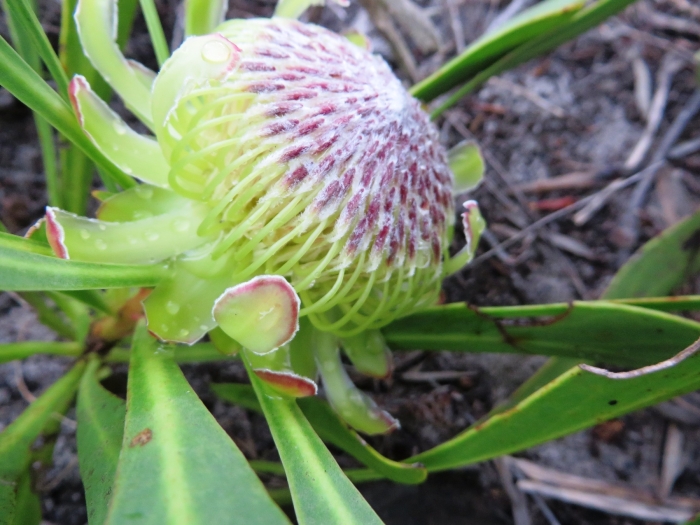Common Ground Sugarbush
(Protea acaulos)
Common Ground Sugarbush (Protea acaulos)
/
/

linkie
CC BY 4.0
Image By:
linkie
Recorded By:
Copyright:
CC BY 4.0
Copyright Notice:
Photo by: linkie | License Type: CC BY 4.0 | License URL: http://creativecommons.org/licenses/by/4.0/ | Rights Holder: linkie | Publisher: iNaturalist | Date Created: 2019-08-11T10:00:42-07:00 |

























Estimated Native Range
Summary
Protea acaulos, commonly known as the Common Ground Sugarbush, is a low-growing, evergreen shrub native to the fynbos region, which includes diverse habitats such as coastal plains, mountainous areas, and heathlands in the southwestern Cape Region of South Africa. This includes specific areas like the Cape Peninsula, Cederberg, Elim Flats, Caledon Swartberg, Riviersonderend Mountains, and the Langeberg Mountains. It typically reaches up to 12 inches in height and spreads to about 3 feet across. The plant has a distinctive growth form with underground branches and a thick rootstock that enables it to resprout after wildfires, a common occurrence in its native fynbos habitat.
Protea acaulos is notable for its large, striking flower heads that bloom from June to November. The flowers are usually pink to red and are pollinated by rodents and birds, an adaptation to its fire-prone environment. In cultivation, it is valued for its unique appearance and resilience, often used in rock gardens, as a ground cover, or in Mediterranean-style landscapes. It requires well-drained, acidic soil and full sun to part shade conditions. While it is drought-tolerant once established, it does not tolerate frost well. There are no major diseases affecting this species, but it can be sensitive to root disturbance due to its thick rootstock.CC BY-SA 4.0
Protea acaulos is notable for its large, striking flower heads that bloom from June to November. The flowers are usually pink to red and are pollinated by rodents and birds, an adaptation to its fire-prone environment. In cultivation, it is valued for its unique appearance and resilience, often used in rock gardens, as a ground cover, or in Mediterranean-style landscapes. It requires well-drained, acidic soil and full sun to part shade conditions. While it is drought-tolerant once established, it does not tolerate frost well. There are no major diseases affecting this species, but it can be sensitive to root disturbance due to its thick rootstock.CC BY-SA 4.0
Plant Description
- Plant Type: Shrub
- Height: 0.5-1 feet
- Width: 3-6 feet
- Growth Rate: Slow
- Flower Color: Red, Pink
- Flowering Season: Winter, Spring
- Leaf Retention: Evergreen
Growth Requirements
- Sun: Full Sun
- Water: Low
- Drainage: Fast
Common Uses
Drought Tolerant, Low Maintenance, Rock Garden, Showy Flowers
Natural Habitat
Native to the fynbos region, including coastal plains, mountainous areas, and heathlands in the southwestern Cape Region of South Africa
Other Names
Common Names: Ground Protea, Ground Sugarbush
Scientific Names: , Protea acaulos, ? acaulis, Erodendrum glaucophyllum, Erodendrum limoniifolium, Leucadendron acaulon, Protea acaulis, Protea acaulis, Protea angustata, Protea angustata
GBIF Accepted Name: